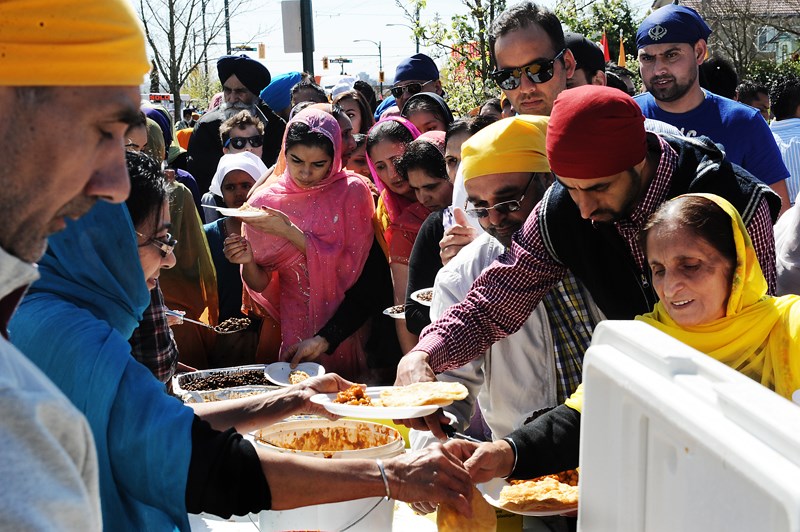Twenty-seven boxes of pizza doesn’t go very far in the presence of thousands of people. But for Pravh Jaswal’s family, it was enough to feed relatives, friends and neighbours who lingered in front of their Marine Drive home a block away from the Ross Street Temple where Saturday’s Vaisakhi parade started.
“It’s a celebration of our religion,” said Jaswal, a student at Sir Winston Churchill secondary who spent her childhood living in the Marine Drive home. “Our family feels that if we contribute food, it makes us feel like part of the festivities.”
Many Sikh families had tables and warming dishes set up outside their homes along the parade route that meandered along Marine and then up Main Street to East 49th to Fraser then to East 57th before heading back to the temple. The vegetarian food, given out for free, is a cultural part of the festival as it pays tribute to India’s ancient harvest celebration. Since 1699, Vaisakhi also marks the birthday of Sikhism. To give an idea of how much food is served outside of a single house, Amajil Grewal, who helped his family serve food near Main and 57th, said they started the morning with 50 pounds of chickpeas and 100 pounds of roti.
The parade moved like a slow-moving wave. The divide between spectator and participant colourfully overlapped as everybody was welcome to walk alongside the handful of decorated trailer trucks including one that commemorated the centennial year of the Komagata Maru incident where mostly Sikh immigrants were denied entry into Canada in 1914. There were also South Asian combat-training demonstrations called gatka where practitioners, including Hardeep Singh, tirelessly and expertly (thanks to his 23 years of practice) leapt and danced with two wooden swords.
Loudly present, also, was the Sikh Motorcycle Club in a mix of gleaming chrome, orange turbans, white shirts and black leather vests.
Club vice-president Amadeep Singh Garcha left his bike at home to walk alongside his riders and invite people to ride the club’s latest edition — a float where volunteers had their hands full teaching anybody and everybody how to wrap a turban.
“Why we wear a turban on our motorcycles is all about Sikh dignity and we try our best to give a positive message to the mainstream,” said Garcha, adding many of the club members grew up in India where riding with a turban is a non-issue.
The Sikh Motorcycle Club is the only one of its kind in Canada, forming after British Columbian Sikhs successfully fought to amend the province’s Motor Vehicle Act to allow those of the Sikh religion to legally ride with turbans in 1999.
As the 25th annual parade stopped every half block or so, riders dismounted while parade spectators put down their paper plates of traditional food from nearby homes to rush over and pose with the bikes for photos.
And it’s this aspect of the festival that is a favourite for Jaswal. “It’s the walking with the parade. I walk it every single year — it’s way too long ago to remember the first time because I was one when I attended my first Vaisakhi,” said the 16-year-old. “It’s fun because I get to see a lot of other friends and relatives. And there’s more food, and different varieties as you walk along. There’s so much walking up and down the hills but if you have fun you don’t really notice the time.”
The annual Vancouver Vaisakhi festival, hosted by the Khalsa Diwan Society, is one of the largest in Canada behind this Saturday’s Vaisakhi parade in Surrey, one of the largest in the world.



